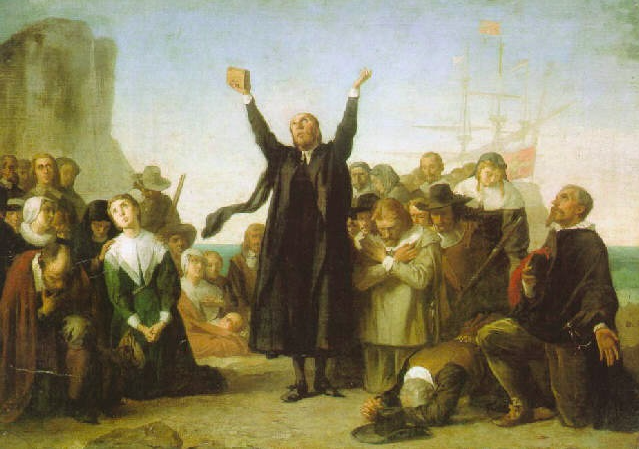Join us as we begin a series of posts focusing on the prioritization of religious freedom in American law and culture. This week our discussion focuses on religious liberty in American during the nineteenth century and is was initiated by Richard Garnett’s post “Religious Freedom in Early America: Complicating the Common Narrative.”
By: Nathan Oman
George Santayana once observed that having a religion that is no religion in particular is as difficult as speaking a language that is no language in particular. This is certainly true of religious freedom in the United States in the nineteenth century. In the religious model that emerged in the decades before the Civil War, legitimate religion consisted of denominational diversity within a Protestant model of Christianity. Religion that diverged sharply from a model of congregational Protestantism was classified not as “religion” but as “fanaticism.” Methodists, Baptists, and Presbyterians were religious believers. Catholics and Mormons were fanatics, a classification that allowed Protestant America to affirm both religious freedom and legal hostility toward non-Protestants.
Consider a legal realm that is seldom discussed: nineteenth-century corporate law.
Churches are among the earliest corporations known to our law. Prior to the early nineteenth century, churches gained their legal existence either through a special act of the legislature or through a legal fiction known as “corporation by prescription,” in which such a charter was assumed to have been issued in the past and then inadvertently lost or forgotten.
This changed in the early years of the republic. New York passed a general incorporation statute for churches. The legal creation of a new church no longer required a special act of the legislature or judicial contortions. This was the statute under which Joseph Smith sought to organize what would become the Church of Jesus Christ of Latter-day Saints.
General church incorporation statutes in New York and other states assumed that churches would be congregationally structured, with the laity exercising firm control over the clergy and economic activity limited to generating sufficient income to pay a pastor and maintain a meetinghouse. So-called mortmain provisions sharply limited how much property a church could own, the purposes for which it could be used, and the methods by which it was to be controlled.
At the heart of nineteenth-century Mormonism was what Latter-day Saints called “building Zion.” This was their attempt to establish an ideal religious community, one that would reject both the worldly economic order and the monogamous model of the family. The quest to “build Zion” resulted broke with the decentralized congregational model of American Protestantism, concentrating ecclesiastical control. Furthermore, because the Mormon Church understood itself in large part as a builder of cities and commonwealths, its activities at various times included banking, real estate development, shipping and immigration, industrial development, irrigation management, legal dispute resolution, and a host of other “non-religious” activities.
This proved impossible within the confines of existing church law. One of the first acts of the Utah Territorial Legislatures in the 1850s, when the Mormons achieved some limited local autonomy, was to grant a capacious charter to the Mormon Church, which placed no limitations on its ability to own and use property. The 1862 Morrill Anti-Bigamy Act, the first Congressional action taken against the Mormons, revoked the this charter, imposing on the Mormons a Protestant model of corporate identity, including a mortmain provision. Likewise, the final act in the legal conflict between the Mormon Church and the federal government took place in the corporate context, with the Supreme Court’s 1890 decision in Late Corporation of the Church of Jesus Christ of Latter-day Saints v. United States, upholding the corporate dismemberment of the church nearly thirty years after it had first been commanded by Congress.
Legal scholars generally tell the story of nineteenth-century Mormonism in terms of a failed campaign of constitutional litigation against the criminalization of polygamy. If we trace the legal trajectory of Mormonism from its first attempted incorporation in 1830 to its final disincorporation in 1890, we see a different story. In this story, the Mormons struggle against the Protestant assumptions embedded in American law by trying to create legal alternatives of their own, alternatives that Congress met with hostility. First Amendment issues arise only sporadically.
The Mormon defeat on the ecclesiological front was not as total as their surrender on polygamy. To be sure, by the close of the nineteenth-century Mormonism had abandoned its most ambitious “Zion building” projects. The Mormon Church, however, ultimately escaped the Protestant ecclesiastical model that Congress sought to impose on it. In part this was because of the waning of political hostility toward the Church, but in large part it was because the Church adapted a new legal mechanism that appeared after the Civil War—the general business incorporation statute—to its purposes, organizing many of its broader efforts as nominally for-profit corporations rather than ecclesiastical corporations.
What we see in this process is political and legal negotiation over the scope of religious freedom, but it is a process that occurs largely outside of the realm of constitutional adjudication. It is a story that requires abandoning the “law office history” that Professor Garnett rightly criticizes and venturing into a non-constitutional realm that scholars and students of religious freedom too often ignore.
Nathan B. Oman is the Cabell Research Professor of Law at William and Mary Law School where he teaches course on contract law, economic analysis of law, jurisprudence, law and religion, and legal history.
This piece was originally authored on May 30, 2014 for the Religious Freedom Project at Georgetown’s Berkley Center for Religion, Peace, and World Affairs.
THE RFI BLOG

Myths of Religious Nationalism in America and Abroad

France’s Olympic Hijab Ban Violates International Law And Exacerbates Tensions

RFI Briefs USCIRF on Lessons from 25 Years of U.S. Designating Religious Freedom Violators

Thought Police: Protecting the People from Prayer

A Religious “Delaware”: Establishing a State Haven for Religious Corporations
CORNERSTONE FORUM

Challenges to Religious Freedom in Iraq and the Critical Need for Action

Public Bioethics & the Failure of Expressive Individualism

Religious Liberty in American Higher Education

Scotland’s Kate Forbes and the March of Secularism


